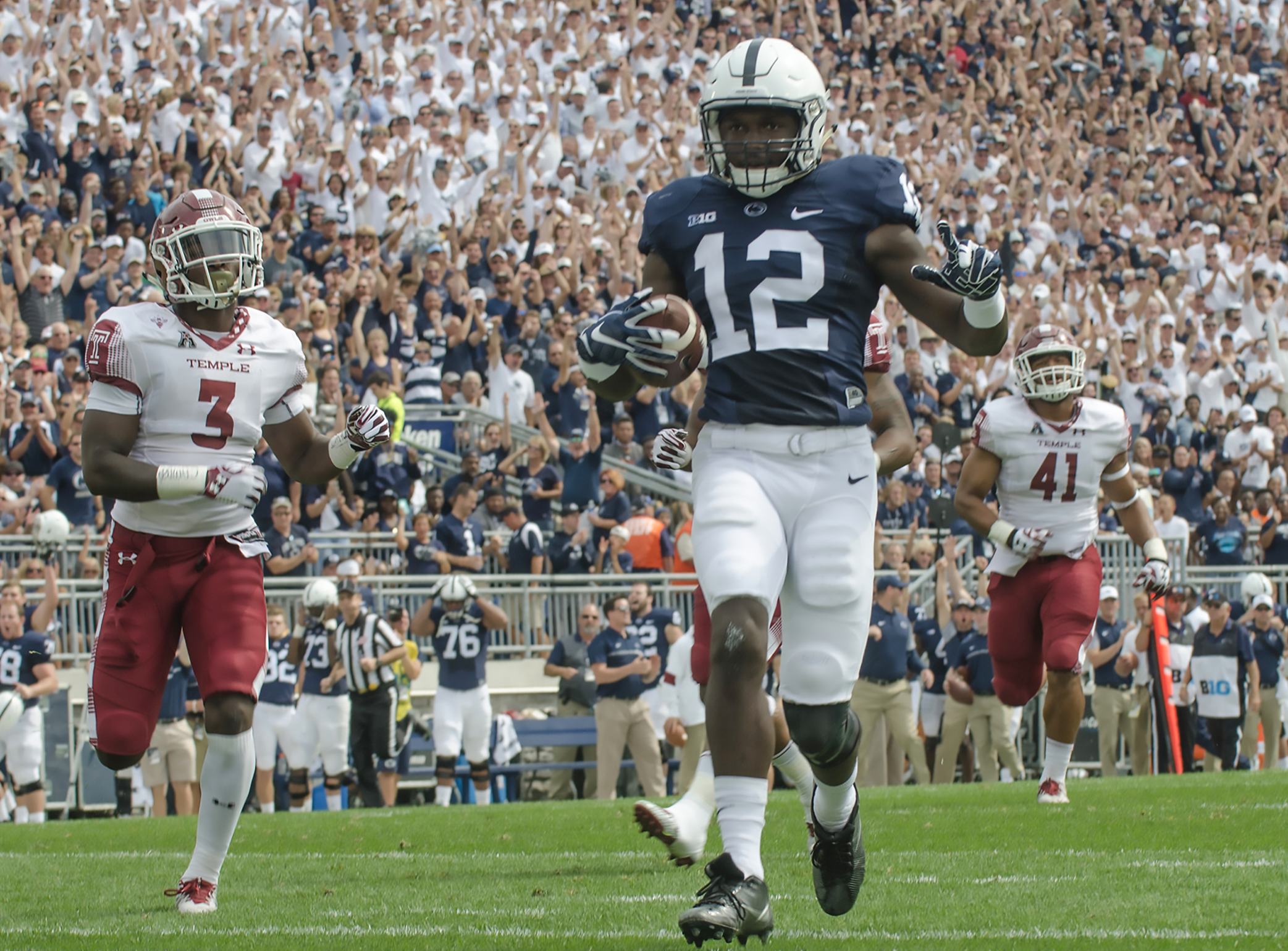Now is a fascinating time to take stock of the future of the wide receiver position at the NFL level. On a broad level, Andy Reid’s quote that the college game is generally five years ahead of the pros has proved prescient, as the Air Raid offenses that came to define NCAA football in the 2010s appear on the verge of widespread adoption by NFL teams with a franchise quarterback in place. Led by Patrick Mahomes, Reid’s Chiefs are perhaps the best example of this, which can be seen elsewhere with ex-Texas Tech coach Kliff Kingsbury’s hiring in Arizona and Reid protege Doug Pederson’s Carson Wentz-centric scheme in Philadelphia.
There aren’t many hard and fast rules on which wide receivers are best suited for such a pass-heavy approach, but it appears teams prefer elite speed over elite size. Case in point: the Alabama Crimson Tide. We all know Nick Saban can recruit whomever he pleases, and he built the NCAA’s most formidable wide receiving corps this past year. Even with Tua Tagovailoa injured for half of the season, the Tide had four wideouts go for over 500 receiving yards. Jerry Jeudy and Henry Ruggs are virtual locks for the top 20 in April’s NFL Draft – DeVonta Smith and Jaylen Waddle won’t go much later than that next year. And what made the quartet so terrifying? All four of them run sub-4.5 second 40 yard dashes. Ruggs just ran a 4.27 at the NFL Combine. None of the four standouts are over 6’1”.
The Chiefs’ wide receivers look strikingly similar, though tight end specimen Travis Kelce is arguably their top threat through the air. KC also rolls out four wideouts over the course of the game, including two absolute burners in Tyreek Hill and Mecole Hardman, who run about 4.3-second 40s. Again, nobody is over 6’1”. Only Demarcus Robinson ran slower than 4.5 at the Combine. Reid and offensive coordinator Eric Bieniemy wanted lightning in a bottle at the expense of serious size – and uncorked it at up to four spots on any given play – from there, they just let Mahomes do his thing. That formula was enough to win Kansas City the Lombardi Trophy despite the Chiefs’ pedestrian defense.
Saban is doing it. Reid is doing it. So, the ideal wide receiver for the future of the NFL is a speedster above all else? It’s not that simple.
Size absolutely still moves the needle at wideout. This year, six of the NFL’s top seven leaders in receiving yards were 6’2” or taller at a time when the average NFL wide receiver is 6’0”. Seven of the top eight receiving touchdown leaders were at least that tall. The only exception was Tampa Bay breakout star Chris Godwin, who still checks in at a sturdy 6’1”, 209.
Throwing to big frames absolutely helps QBs, too. Looking at some of the best individual seasons posted by signal-callers, there has almost always been a large receiver (or at least a dominant tight end) in place for them. When he posted the best single-season passer rating of all time in 2011, Aaron Rodgers’ leading receiver was the 6’3” Jordy Nelson and none of the other three wideout regulars were shorter than 6’0”. 6’4” terminator Randy Moss starred in Tom Brady’s legendary 2007 season, while the devastating tight end combination of Rob Gronkowski and Aaron Hernandez combined for over 2,200 yards during Brady’s other most prolific campaign, in 2011. In the first incredible stretch of Drew Brees’ career between 2012-13, 6’7” Jimmy Graham featured with one of the best seasons ever by a tight end in 2013, while the 6’4”, 225-pound Marques Colston averaged 1,049 yards across the two seasons. Brees’ recent dominance has highlighted the 6’3” Michael Thomas, who has comfortably established himself as the NFL’s best wide receiver while averaging 1,565 yards between 2018-19.
You get the picture. Perhaps more pertinently, among incredible outlier-type seasons posted by quarterbacks that certainly aren’t bound for the Hall of Fame, there has generally been a multitude of well-built options in the passing attack. Nick Foles actually posted the third-highest single-season passer rating of all time in 2013, which many Eagles fans will remember fondly as the peak of LeSean McCoy and DeSean Jackson’s careers. However, Foles’ second-leading receiver was the 6’3” Riley Cooper, who went for 850 yards, while the tight end duo of Zach Ertz and Brent Celek both eclipsed 450 yards each. Ryan Tannehill posted the fourth-highest passer rating of all time this past season, and his leading receiver was the tremendously imposing 6’1”, 226-pound rookie AJ Brown, while Brown was followed by Corey Davis, who checks in at 6’3”. When Ryan Fitzpatrick posted the best yards-per-attempt of all time in 2018, 6’5”, 231 mammoth Mike Evans caught balls for over 1,500 yards, while Godwin went over 800 and 6’6”, 251 tight end OJ Howard had 565 yards himself.
The best example of a historic season enjoyed by a quarterback without an overwhelming pass-catcher might be from Peyton Manning in 2004, when he set the highest passer rating ever at the time. Three wide receivers — Reggie Wayne, Marvin Harrison, and Brandon Stokely — had more than 1,000 yards for Peyton, and they all stood six-foot on the nose. Manning was aided by a dominant Edgerrin James in the backfield and had two tight ends surpass 300 yards, but this Colts attack still sounds more like Alabama’s current approach.
The traditional narrative around jumbo-sized wideouts is that they’re supposed to dominate in the red zone, using their frames to box out defensive backs and high-point footballs. This generally holds true when examining last season’s statistics, as the five pass-catchers with five-plus touchdowns inside the 10-yard line all stand 6’1” or taller. Among quarterbacks that excelled in the red zone last season, Fitzpatrick and Jameis Winston jump off the page as surprising inclusions. Both certainly had their share of big pass-catchers, with Fitz primarily throwing to DeVante Parker, Preston Williams, and Mike Gesicki in Miami while Jameis dealt to Tampa Bay’s aforementioned group, with Evans, Godwin, and tight end Cameron Brate combining for eleven touchdowns inside the 10. Meanwhile, in his 20-TD, 0-INT 2018 red zone campaign, the oft-scorned Kirk Cousins had a fairly large (but mostly just… talented) group of targets featuring Stefon Diggs (6’0”, five TDs inside the 10), Adam Thielen (6’2”, four), and Kyle Rudolph (6’6”, two).
The counter to this evidence might be Mahomes’ ridiculous 2018 season, where he threw a whopping 35 red zone TDs against only one pick. Mahomes’ leading pass-catchers were Kelce (6’5”, nine red zone TDs), Chris Conley (6’3”, five) and Tyreek Hill (5’10”, five). It’s hard to say how this shapes the size-in-the-red-zone argument, but it’s important to keep in mind that Mahomes is also Mahomes and plays in contrast to much of what we fans thought we knew about football.
Add up all of these notes, and there’s no clear picture of how to build a modern pass-catching group. On one hand, there’s what grand schemers Saban and Reid are doing with an emphasis on wheels, wheels, wheels. On the other, the NFL’s best statistical wide receivers skew bigger, and almost all of the historically great passing offenses in recent memory have had targets with some serious size. This has to be quite frustrating for the general managers of NFL organizations with fanbases clamoring for a highly-drafted wide receiver in April’s NFL Draft, like the Eagles, Bills, and Raiders. Jeudy, Ruggs, and Oklahoma’s CeeDee Lamb all figure to be off the board within the top fifteen picks and have the college production and elite athleticism to back up that notion. After that, drafting a wideout is almost always a crapshoot, but this year’s class is considered extremely strong — NFL Network’s Daniel Jeremiah has a Round 1-3 grade on a stunning 27 wide receivers.
Sifting through the results of recent wide receivers selected in the first round is an eye-opening task because of the sheer number of busts to observe, and analyzing their measurables doesn’t point to one body type panning out more than another. Since 2013, there have been 25 wideouts picked in the first. With the average NFL wide receiver measuring exactly 6’0”, 200 pounds, I’ll consider a particularly tall wide receiver anyone 6’2” or taller and a particularly heavy wideout anyone 215 pounds or more.
The 25 first-round wide receivers since 2013 break down as such (measurables listed as recorded at the NFL Combine):
(6’2”-plus, 215-plus): Cordarrelle Patterson, Kelvin Benjamin, Mike Evans, Kevin White, Laquon Treadwell, Mike Williams, N’Keal Harry (7)
(6’2”-plus, 215 or less): Breshad Perriman, De’Vante Parker, Josh Doctson, Corey Davis (4)
(6’2” or smaller, 215-plus): None
(6’2” or smaller, less than 215): Tavon Austin, De’Andre Hopkins, Brandin Cooks, Odell Beckham Jr., Sammy Watkins, Phillip Dorsett, Nelson Agholor, Amari Cooper, Will Fuller, Corey Coleman, John Ross, Calvin Ridley, DJ Moore, Marquise Brown (14)
Now, I’m really confused. Though the first-rounders that aren’t particularly tall have certainly had more success overall, there are a few flops on that list like Austin, Dorsett, Coleman and Ross. But the taller first-rounders aren’t impressive at all except for Evans and Parker, who may have resurrected what was a bust-labeled career with a bounce-back 2019. Juxtapose this with the fact that the NFL’s best wideouts today are certainly on the bigger side, and we’re left with…your cornerstone wide receiver is likely to be a big target, but take him after the first round?
That strategy is obviously a fool’s errand. But consider the NFL’s top players at the position. Thomas was a second-rounder in 2016. Kenny Golladay, who finished 7th in receiving yards this season and tied for the league lead in touchdowns inside the 10, came off the board 96th overall in 2017. Godwin, second this season in yards per game, was snagged twelve picks before Golladay. Cooper Kupp, who was tied with Golladay with six TDs inside the 10, was another 2017 third-rounder. Keenan Allen, a former third-rounder, finished sixth in receiving yardage this year. Allen Robinson, eighth in yardage, was selected 61st overall in 2014. On and on we go. Meanwhile, AJ Brown, the sturdy 6’1”, 226-pound rookie second-rounder, might be on his way to becoming one of the game’s most feared wideouts alongside Thomas and Julio Jones, because of just how hard he is to tackle. There wasn’t a single first-round wide receiver since 2013 with his type of compact frame.
In summation, it’s nearly impossible to predict which wide receiver prospects will go on to enjoy NFL stardom, first-round grade or not. Though size is a common denominator among today’s elite at the position, taking tall wide receivers in the first has been a shot in the dark. I don’t envy the task in front of many general managers at the 2020 Draft one bit.





